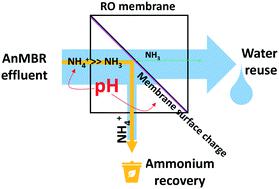当前位置:
X-MOL 学术
›
Environ. Sci.: Water Res. Technol.
›
论文详情
Our official English website, www.x-mol.net, welcomes your
feedback! (Note: you will need to create a separate account there.)
Optimization of reverse osmosis operational conditions to maximize ammonia removal from the effluent of an anaerobic membrane bioreactor
Environmental Science: Water Research & Technology ( IF 3.5 ) Pub Date : 2021-2-23 , DOI: 10.1039/d0ew01112f Chungheon Shin 1, 2, 3, 4, 5 , Aleksandra Szczuka 1, 2, 3, 4, 5 , Renjing Jiang 1, 2, 3, 4, 6 , William A. Mitch 1, 2, 3, 4, 5 , Craig S. Criddle 1, 2, 3, 4, 5
Environmental Science: Water Research & Technology ( IF 3.5 ) Pub Date : 2021-2-23 , DOI: 10.1039/d0ew01112f Chungheon Shin 1, 2, 3, 4, 5 , Aleksandra Szczuka 1, 2, 3, 4, 5 , Renjing Jiang 1, 2, 3, 4, 6 , William A. Mitch 1, 2, 3, 4, 5 , Craig S. Criddle 1, 2, 3, 4, 5
Affiliation

|
Anaerobic membrane bioreactors can now produce effluent that meets regulatory standards for BOD, enabling energy recovery and use of the treated effluent for irrigation. RO treatment of this effluent can potentially enable recovery of potable water and total ammonia nitrogen (TAN). In this study, we optimized the removal of TAN from the effluent of a staged anaerobic membrane bioreactor (SAF-MBR), a system that consists of an anaerobic fluidized bed reactor and anaerobic membrane bioreactor. The SAF-MBR effluent was treated using an ESPA RO membrane. The result was a high-quality RO permeate that meets the typical potable water guidelines (≤1 mg N L−1). Hydraulic operating conditions (i.e., pressure and flux settings) did not affect TAN rejection efficiency, but pH had major impacts, due to changes in ammonium/ammonia speciation and membrane surface charge. At pH 6, the TAN rejection efficiency was optimal at 99.8%. For pH > 6, the passage of uncharged NH3 increased, decreasing TAN removal. For pH < 6, the membrane retained a progressively less negative (carboxylate) charge as the pH decreased, decreasing ammonium removal from the optimum and allowing increased passage of ammonium into the permeate. Our results suggest that an RO membrane having a lower isoelectric point (IEP) can enable higher TAN rejection efficiencies. A more concentrated RO retentate enables more efficient recovery of ammonia for reuse, and the energy required is less than the energy needed for biological removal of NH3 as N2 followed by synthesis of NH3 from N2 by the Haber–Bosch process. Further systems level research is needed to assess the energy intensity of different options for recovery and reuse of concentrated ammonia.
中文翻译:

优化反渗透操作条件,以最大程度地从厌氧膜生物反应器的废水中去除氨
厌氧膜生物反应器现在可以生产出符合BOD法规标准的废水,从而实现能量回收和将处理后的废水用于灌溉。对该废水进行RO处理可以潜在地回收饮用水和总氨氮(TAN)。在这项研究中,我们优化了分阶段厌氧膜生物反应器(SAF-MBR)的出水效果,该系统由厌氧流化床反应器和厌氧膜生物反应器组成。使用ESPA RO膜处理SAF-MBR废水。结果是符合典型饮用水准则(≤1mg NL -1)的高质量RO渗透物。液压工况(即(压力和通量设置)不会影响TAN的去除效率,但由于铵/氨形态和膜表面电荷的变化,pH值会产生重大影响。在pH 6时,TAN排斥效率最佳,为99.8%。对于pH> 6的情况,不带电荷的NH 3的通过增加,从而减少了TAN的去除。对于pH <6,随着pH的降低,膜上保留的负电荷(羧酸盐)逐渐减少,从而使铵从最佳状态的去除减少,并使铵进入渗透液的通道增加。我们的结果表明,具有较低等电点(IEP)的RO膜可以实现更高的TAN排斥效率。更高浓度的RO截留液可以更有效地回收氨以进行再利用,所需能量少于生物去除NH所需的能量。3以N 2的形式存在,然后通过Haber-Bosch工艺从N 2合成NH 3。需要进一步的系统级研究来评估回收和再利用浓氨的不同选择的能量强度。
更新日期:2021-03-09
中文翻译:

优化反渗透操作条件,以最大程度地从厌氧膜生物反应器的废水中去除氨
厌氧膜生物反应器现在可以生产出符合BOD法规标准的废水,从而实现能量回收和将处理后的废水用于灌溉。对该废水进行RO处理可以潜在地回收饮用水和总氨氮(TAN)。在这项研究中,我们优化了分阶段厌氧膜生物反应器(SAF-MBR)的出水效果,该系统由厌氧流化床反应器和厌氧膜生物反应器组成。使用ESPA RO膜处理SAF-MBR废水。结果是符合典型饮用水准则(≤1mg NL -1)的高质量RO渗透物。液压工况(即(压力和通量设置)不会影响TAN的去除效率,但由于铵/氨形态和膜表面电荷的变化,pH值会产生重大影响。在pH 6时,TAN排斥效率最佳,为99.8%。对于pH> 6的情况,不带电荷的NH 3的通过增加,从而减少了TAN的去除。对于pH <6,随着pH的降低,膜上保留的负电荷(羧酸盐)逐渐减少,从而使铵从最佳状态的去除减少,并使铵进入渗透液的通道增加。我们的结果表明,具有较低等电点(IEP)的RO膜可以实现更高的TAN排斥效率。更高浓度的RO截留液可以更有效地回收氨以进行再利用,所需能量少于生物去除NH所需的能量。3以N 2的形式存在,然后通过Haber-Bosch工艺从N 2合成NH 3。需要进一步的系统级研究来评估回收和再利用浓氨的不同选择的能量强度。











































 京公网安备 11010802027423号
京公网安备 11010802027423号